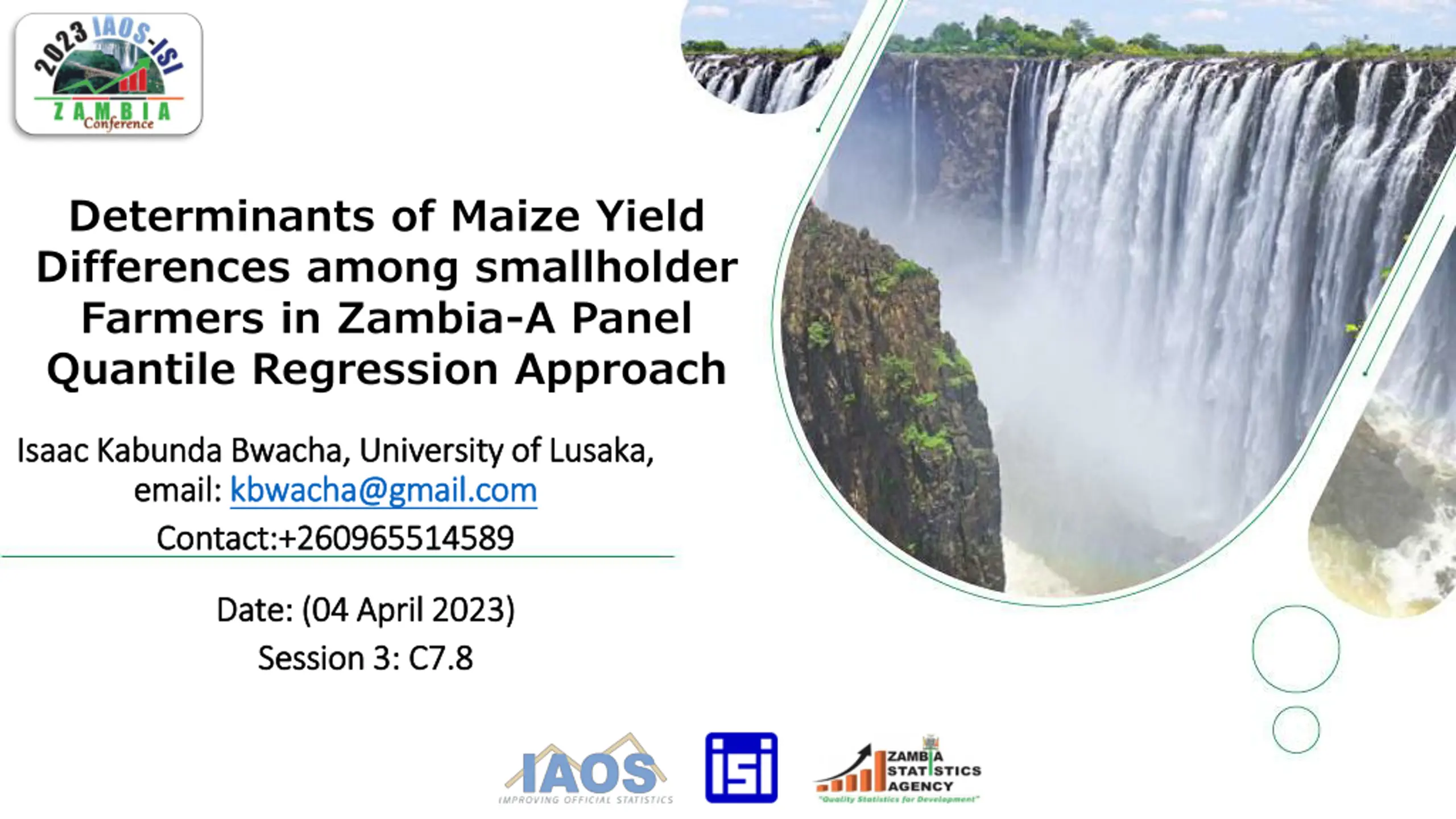Determinants of Maize Yield Variation in Zambian Smallholder Farming
Explore factors influencing maize productivity in Zambia, aiming to enhance smallholder agricultural efficiency. Investigate yield differences at distinct points using panel quantile regression. Objectives include assessing input profitability and strategies for boosting maize output.
Download Presentation

Please find below an Image/Link to download the presentation.
The content on the website is provided AS IS for your information and personal use only. It may not be sold, licensed, or shared on other websites without obtaining consent from the author.If you encounter any issues during the download, it is possible that the publisher has removed the file from their server.
You are allowed to download the files provided on this website for personal or commercial use, subject to the condition that they are used lawfully. All files are the property of their respective owners.
The content on the website is provided AS IS for your information and personal use only. It may not be sold, licensed, or shared on other websites without obtaining consent from the author.
E N D
Presentation Transcript
Determinants of Maize Yield Differences among smallholder Farmers in Zambia-A Panel Quantile Regression Approach Isaac Kabunda Bwacha, University of Lusaka, Isaac Kabunda Bwacha, University of Lusaka, email: email: kbwacha@gmail.com kbwacha@gmail.com Contact:+260965514589 Contact:+260965514589 Date: ( Date: (04 April 2023 04 April 2023) ) Session 3: C7.8 Session 3: C7.8
Motivation of the Study Motivation of the Study Zambia s agric sector is vital for incomes, employment and food security. Employs two-thirds of the labour force, for the majority of Zambians in rural areas (World Bank 2015). Despite recording bumper harvests in recent years, which was due to increased land for maize (from 1million hectares to 1.5 million hectares between 2010 and 2016, (IAPRI 2018). Low crop yield continues to be a challenge in Zambia as is the situation in a number of Sub-SaharanAfrican countries. Average Output stands at below 2.0 tones/ha compared to potential of over 6 tones/ha. This calls for studies to examine efficiency of smallholder maize agricultural production in Zambia.
Why this study? Why this study? Numerous Maize productivity studies done in Zambia have investigated the determinants of maize productivity using the conditional mean approach. This paper argues that it is more meaningful and relevant to investigate productivity determinants at different points (Quantiles). Factors determining productivity may vary in sign and magnitude at different points (Quantiles) of the maize production distribution.
Problem Statement According to RALS (2017) maize yield have increased only modestly, from 1.321 t/ha to 1.750 t/ha over the period 2004 and 2020. Rather than productivity gains, the real driver of the growth in maize is the area under maize cultivation, which rose by 50%, from roughly 1 million hectares on average between 2004 and 2009, to over 1.5 million hectares in 2020. The Zambian maize yield potential stands at 6 t/ha but average observed maize yields remain below 2 t/ha. Secondly, the maize yield distribution curve suggests that although the national average of maize yield stands at less than 2 t/ha, there is a portion of farmers in the 90thquantile that are highly productive with yield of over 6t/ha. Understanding characteristics of highly productive farmers can help in designing interventions for less productive farmers
Objectives of the Study 1.2 General Study Objective The general objective of the study was to analyze input profitability and potential for increasing productivity in maize farming in Zambia. 1.3 Specific Objectives 1. To examine yield differences by Gender, Age, Education Level and Extension services. 2. To evaluate whether fertilizer and seed interventions can improve maize productivity in the lower quantile of the maize yield distribution curve. 3. To identify the characteristics of the most productive farmers in the 90% quantile of the maize distribution curve. 4. To determine the profitability of fertilizer and seed rate using the value-cost ratio.
Methods The study adopted a. Quantitative and descriptive research design. The RALS data set provides comprehensive information on 7,254 panel households and it derives its sampling frame from the Zambia 2010 census. Dependent Variable: Maize yield: Independent Variables: 1. Production Variables: Area planted as Land, Quantity of seed, and Adult Equivalent household size as Labour, Land Holding Size as Wealth or Capital. Secondly, 2. Household demographic characteristics: Gender of household Head and Marital Status. Lastly, 3. Policy Variables: Extension advice, agriculture techniques (Mixed cropping and Tillage). Seed quality, Conservation
Methods Cont... Model specification:? ?? ?jt= ? ? + ? ?Fijt +? ?Xijt + Ci + ijt To control for potential Endogeneity the Correlated Random Effect Model was specified by adding the generated Bar independent variables to the model Why Quantile Regression? i. The estimated coefficients are not sensitive to outliers of the dependent variable. ii. The QR is more efficient when errors are not normally distributed. iii. The QR also enables researchers to pre-define any positions of the distribution according to their specific inquiries.
Fertilizer and Seed Profitability This study used the value-cost ratio (VCR). VCR compares the costs of applying fertilizer and seed with the value of output that the two inputs generate. A VCR of two is a more certain indication of profitability. Diagnostic Tests 1. Linearity Test 2. Multicollinearity Test 3. Heteroskedasticity Test The Breusch-Pagan/Cook-Weisberg test was used. The test was significant at one percent suggesting that the data exhibited heteroscedasticity since we reject Homoskedasticity. To correct for heteroscedasticity, the robust option for standard errors was used in both the OLS and quantile regressions. the hull hypothesis of
Conclusion This study investigated the determinants of yield differences, using a quantile regression approach, which allows parameters to vary across maize productivity groups. Results show that estimates for conditional mean regression with OLS could be misleading. Recommendations 1). Develop technologies that are tailored to the needs of the smallholder farmers. 2). Enhance the rate of adoption of improved technologies such as use of hybrid seed, and use of fertilizers among smallholder farmers both male and female. 3). Promote conservation agriculture and Improve extension services since these factors improve yield.























